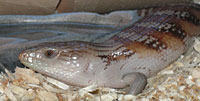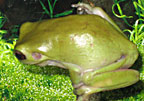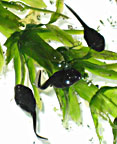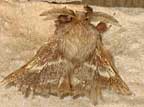 | ||||||||||||||||
|
Pets
Northern Blue Tongue Skinks are desert lizards from the northern deserts of Australia (which explains the name). However, other sub-species of Blue Tongue Skink live in more southern Australiain deserts (Northerns are also a sub-species). Ollie lives in a 20 gallon terrarium with a basking rock, water dish, food bowl and hide tube with aspen shavings as the substrate. Ollie LOVES to bury in the aspen instead of hiding in the tube. But he/she uses the tube, also. Ollie's diet consists of fruit, such as blueberries and grapes, veggies, such as cucumber and celery, or Ollie's favorites kale and dandelion greens (from our garden). Also, we give him meat, mostly worms and soft cat food. On June 21, Ollie went into his/her first shed. We help he/she pull off the dead scales. Ollie shed again on July 8 and again on August 16. When we got Ollie, he/she was only 6 inches head to tail. After his third shed, Ollie was almost 13 inches, yet only half the adult size of 24-26 inches. I am now updating the site, so I am adding some new information on Ollie: Ollie now has shed 4 times, and is going into it's 5th shed soon. He has grown to almost 15 inches, but it will not be full size for a few months to almost a year. We still have no idea what its' gender is, so that is why I'm calling Ollie an "it" (I am not trying to insult it, in case you were wondering). Travis - My Dad caught our second American toad in our backyard in Summer of 2007. We named him Travis Oscar Allen Douglas Yaz (Travis for short), which is acronym for Toady. We think he is a boy because he is smaller than Toady. Although, we've never heard him croak. We feed him 6 large crickets, once a week. He lives in Toady's old terrarium, with peat moss and a water dish. :) Toady - My Mom caught our American Toad in our backyard in the Summer of 2005. I had just come back from summer camp, and was showing Mom something in the yard. Then Mom spotted Toady, caught her, and that's why we have Toady now. Interestingly, my Mom's Dad also caught a toad in their back yard, and kept it for a pet. I guess this is a family tradition now. Initially, we fed her six large crickets once a week (since Dumpy came along, we feed her twice a week). Now that she is getting older and having more problems eating, we give her six small crickets. We have a terrarium with peat moss and a water dish. That's all she needs. She sits in the water dish, and gets water through her skin. We think that Toady is a female, because she doesn't croak, has a light throat, and is larger, like most female American toads. In August 2006, we celebrated the one year anniversary of Toady being a member of our family. During the recent heat wave, she spent alot of time in her water dish keeping cool. She grew to be very big. Unfortunately, she died in June 2007. :( We are glad that she had been our pet.
We know now that he sings, and therefore, is a male frog. He surprised us one day by letting out this long string of barking noises. One night in August, 2006, Mom heard Dumpy calling from the bedroom, despite Dad's snoring and the TV blaring. Now that's loud! :0
Most of the tapdoles metamorphosed into toadlets in July, 2006. Before that we could see that they were growing four legs, and I called these "toadish" before they emerged from the water to the land. Now that they are on the land, I collect buggy dirt full of tiny insects for them to eat every 2-3 days. Unfortunately, the toadlets have died. Only one was left in August, 2006, and this one died around Thanksgiving, 2006 :(. On my eighth birthday, Mom and Dad gave me a tadpole kit as a gift. We intend to try again this summer.
| As an 8 year old
Neopets As a 7 year old Philly Forecast As a 6 year old: NASA-Hurricanes Accuweather-Hurricane As a 5 year old: NASA-planets NASA-JPL NOAA-storm lab As a 3-4 year old: bob the builder disney.com hbofamily.com nickjr.com noggin.com | ||||||||||||||

 Oliver - Oliver, our Northern Blue Tongue Skink, (Yes, he does have blue tongue!) arrived as a baby on June 19, 2009. He/she (we are not sure if it's a boy or a girl) was born on June 9, 2009. Ollie, a.k.a Dino or Lizard Lord was bred and sold to us by a professional breeder.
Oliver - Oliver, our Northern Blue Tongue Skink, (Yes, he does have blue tongue!) arrived as a baby on June 19, 2009. He/she (we are not sure if it's a boy or a girl) was born on June 9, 2009. Ollie, a.k.a Dino or Lizard Lord was bred and sold to us by a professional breeder. Dumpy - A
Dumpy - A  Tadpoles - We got our tadpoles on the "Polliwog Pail Patrol." This is their story. We were biking down to a ditch that caught rainwater, and noticed that they were all in a small pool that was drying up. The rest of the ditch was dry, and we saved the tadpoles that we could. We moved most of them to a newly constructed wetland in the triangle formed by
Tadpoles - We got our tadpoles on the "Polliwog Pail Patrol." This is their story. We were biking down to a ditch that caught rainwater, and noticed that they were all in a small pool that was drying up. The rest of the ditch was dry, and we saved the tadpoles that we could. We moved most of them to a newly constructed wetland in the triangle formed by 
 About two weeks after spinning the cocoon, Caty emerged as a moth. After watching the moth for two days, we released the moth on the apple tree in our yard. These moths naturally lay their eggs on hardwood trees, such as apple and cherry trees. :)
About two weeks after spinning the cocoon, Caty emerged as a moth. After watching the moth for two days, we released the moth on the apple tree in our yard. These moths naturally lay their eggs on hardwood trees, such as apple and cherry trees. :)